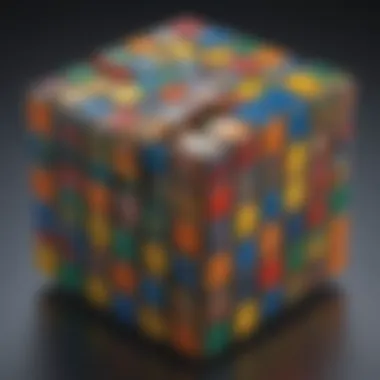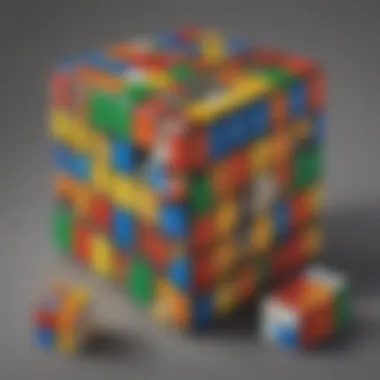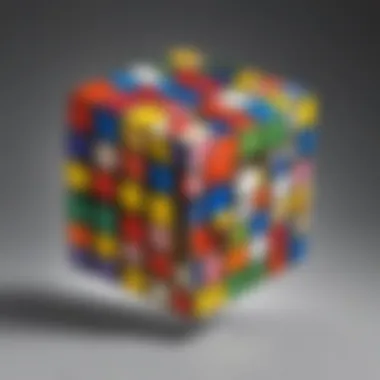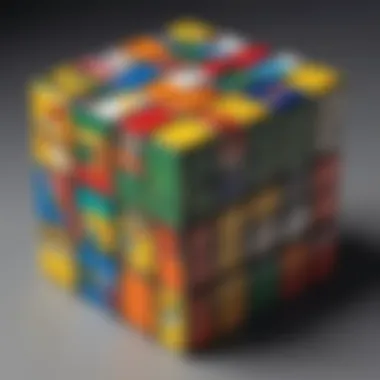Mastering the Rubik's Cube: A Comprehensive Guide to Solving the Puzzle


Science Fun Facts
Interesting Trivia and Facts
Dive into the fascinating world of the Rubik's Cube! Did you know that the Rubik's Cube was invented in 1974 by Hungarian architect Ernő Rubik? It wasn't until 1980 that it gained worldwide popularity, captivating minds with its colorful challenge. Another interesting fact is that the standard 3x3 Rubik's Cube has 43,252,003,274,489,856,000 different possible configurations, making it a true test of logic and patience.
Quirky Science Stories
Unravel the mysteries behind the Rubik's Cube's creation with quirky science stories. Explore how Ernő Rubik initially designed the cube as a teaching tool to help his students understand three-dimensional problems. Dive into the tale of how a simple cube evolved into a global sensation, blending art, design, and science in a captivating puzzle.
Discover the Wonders of Solving the Rubik's Cube
Embark on a journey delving into the wonders of solving the Rubik's Cube, a puzzle that transcends mere entertainment. Explore the intricacies of the cube's structure that challenge both logic and spatial awareness. Discover advanced solving techniques that push enthusiasts to expand their problem-solving skills.
Exploring Various Cube-solving Concepts
Delve into various cube-solving concepts, such as the popular beginner's method and advanced methods like CFOP (Cross, F2L, OLL, PLL). Learn how algorithms play a crucial role in solving the Rubik's Cube efficiently. Understand the significance of patterns and sequences in unraveling the colorful enigma.
Real-life Applications of Cube Solving
Learn how solving the Rubik's Cube goes beyond a mere pastime, offering practical benefits for cognitive development. Enhance your spatial reasoning skills, improve memory retention, and boost problem-solving abilities through regular cube-solving practice. Discover how mastering the Rubik's Cube can sharpen your focus and analytical thinking.
Science Quiz Time
Engage in interactive quizzes and brain teasers centered around the Rubik's Cube. Test your knowledge of cube-solving strategies, algorithm sequences, and pattern recognition. Challenge yourself with multiple-choice questions that deepen your understanding of the Rubik's Cube's intricate design and mechanics.
Learning Through Gamified Challenges
Transform learning into a fun and engaging experience by delving into the world of Rubik's Cube puzzles. Enhance your problem-solving skills through gamification, where challenges become opportunities for growth. Embark on a journey of discovery through interactive quizzes that foster critical thinking and logical reasoning.
Science Experiment Showcase
Immerse yourself in the art of Rubik's Cube experimentation with fun and engaging challenges. Follow step-by-step instructions to master cube-solving techniques, from basic to advanced levels. Equip yourself with a materials list to ensure seamless execution of cube-solving experiments and adhere to safety tips and precautions to enhance your solving experience.
Introduction
In this comprehensive guide on the Rubik's Cube, we delve into the intricate world of solving this challenging yet fascinating puzzle. As we progress through this article, we will uncover the various strategies and techniques essential for mastering the Rubik's Cube, making it an indispensable resource for enthusiasts and beginners alike.
Brief History of the Rubik's Cube
Invention of the Rubik's Cube
The inception of the Rubik's Cube marked a pivotal moment in the realm of puzzles. Its creation revolutionized the concept of spatial logic and problem-solving. The Rubik's Cube, invented by Erno Rubik in 1974, quickly captivated individuals worldwide with its unique combination of mathematics and engineering. Its intricate design and the challenge it posed served as a catalyst for the development of various solving methods, enhancing critical thinking skills among enthusiasts.


Popularity and Cultural Impact
The Rubik's Cube's popularity transcended mere entertainment, morphing into a cultural phenomenon. Its widespread acclaim stemmed from its ability to engage individuals of all ages in a mental workout that offered both entertainment and cognitive development. The Rubik's Cube's cultural impact extended to educational institutions and even competitive arenas, solidifying its status as a timeless classic in the world of puzzles.
Benefits of Solving the Rubik's Cube
Enhanced Spatial Awareness
Solving the Rubik's Cube enhances spatial awareness through the manipulation of its multidimensional structure. The constant engagement with spatial relationships during solving fosters improved spatial cognition and mental visualization abilities. This heightened spatial awareness not only benefits puzzle-solving skills but also extends to real-world applications, such as navigation and geometry.
Improved Problem-Solving Skills
Engaging with the Rubik's Cube hones problem-solving skills by presenting complex challenges that require logical deduction and strategic thinking. Mastering the Rubik's Cube cultivates a structured approach to problem-solving, enhancing analytical reasoning and decision-making abilities. Through consistent practice, individuals develop resilience, perseverance, and adaptability in the face of complex problems, translating these skills to various aspects of life.
Understanding the Rubik's Cube
In the realm of mastering the Rubik's Cube, the pivotal section of 'Understanding the Rubik's Cube' serves as the bedrock for enthusiasts to delve comprehensively into this perplexing puzzle. This segment elucidates the fundamental principles that underpin the cube's functionality, delving into its intricate structure and mechanisms that govern its challenging nature. By grasping this fundamental understanding, solvers equip themselves with the necessary knowledge required to navigate through the subsequent advanced solving techniques with finesse and efficacy.
Cube Notation and Terminology
Face Rotation Notations
Delving deeper into the Rubik's Cube universe leads us to the realm of Face Rotation Notations - a pivotal aspect that simplifies communication and strategy implementation in solving this enigmatic puzzle. Face Rotation Notations allow enthusiasts to articulate and transcribe the precise movements of the cube's faces in a succinct and standardized manner. This notation system plays a crucial role in deciphering complex algorithms and facilitating efficient solving methodologies. Embracing Face Rotation Notations empowers cubers to streamline their solving process, enhancing both speed and accuracy in maneuvering the cube towards its resolved state.
Layer Notations
Complementing the lexicon of Rubik's Cube aficionados, Layer Notations provide a comprehensive framework for discerning the movement and arrangement of layers within the cube. By segmenting the cube's components into distinct layers, this notation system offers a systematic approach to visualizing and executing solving strategies. Layer Notations elucidate the spatial relationships between different sections of the cube, enabling solvers to strategize and optimize their moves with precision and foresight. Mastering Layer Notations equips cubers with a cognitive map to navigate the complex Rubik's Cube terrain with confidence and efficacy.
Cube Structure and Mechanics
Center, Edge, and Corner Pieces
Delving into the inner workings of the Rubik's Cube unveils the intricate dance of Center, Edge, and Corner Pieces - the building blocks that harmonize in perfect synchronicity to form the cube's structure. Center Pieces serve as the anchor points around which the cube rotates, while Edge and Corner Pieces interlock to create the mosaic of colors that characterize the cube. Understanding the distinct roles and positioning of these pieces is essential for solvers to comprehend the logic behind the cube's permutations and combinations, paving the way for strategic solving and algorithm execution.
Mechanism of Cube Movements
Embarking on a journey of cube exploration necessitates an appreciation of the Mechanism of Cube Movements - the mechanical symphony that orchestrates the rotations and twists integral to the Rubik's Cube's functionality. This aspect delves into the intricate gears, springs, and axes that facilitate the smooth yet resilient movements of the cube. Understanding the nuances of cube mechanics empowers solvers to anticipate and optimize their twists and turns, culminating in a seamless solving experience characterized by fluidity and precision.
Basic Solving Methods
Solving the Rubik's Cube involves a strategic approach that moves from principles to practice. In this section, we delve into the foundational methods crucial for mastering the cube with finesse and efficiency. Understanding the basic solving methods forms the cornerstone of solving this intricate puzzle, honing your problem-solving abilities and spatial awareness. By grasping these fundamental techniques, you set a strong foundation to progress into more advanced strategies, laying the groundwork for Rubik's Cube triumph.
Beginner's Layer-By-Layer Method


Cross
The Cross stage within the Beginner's Layer-By-Layer Method is pivotal in setting the stage for solving the Rubik's Cube systematically. This method focuses on assembling a cross on one face of the cube, providing a structured starting point for further maneuvers. The Cross not only assists in orienting the cube but also serves as a visual guide for subsequent steps. Its simplicity and effectiveness make it a popular choice for beginners, offering a clear path to initiate the solving process. While the Cross might seem straightforward, its significance cannot be underestimated, as it acts as the anchor for constructing the first layer of the cube.
First Layer Corners
Transitioning from the Cross, the First Layer Corners step enhances the complexity of the solving process by introducing corner pieces into the equation. This phase involves positioning the corner pieces to align with the corresponding edges, forming a completed first layer. Addressing the First Layer Corners requires meticulous attention to detail and strategic placements to ensure accuracy in assembling the cube. While challenging, mastering this step refines your spatial cognition and fine-tunes your hand-eye coordination. The intricacies of maneuvering the corner pieces add depth to the solving experience, offering a blend of logic and dexterity in achieving a coherent first layer.
Second Layer Edges
Middle Layer Edges
Advancing to the Second Layer Edges marks a progression in solving the Rubik's Cube, focusing on completing the middle layer with precise edge placements. Maneuvering the edge pieces to align within the second layer demands a strategic approach that builds upon the foundation established in earlier stages. The Middle Layer Edges step challenges your spatial reasoning and analytical skills, requiring a blend of methodical calculations and fluid movements. While mastering this phase enhances your cube-solving proficiency, it also introduces complexities that deepen your understanding of the cube's mechanics. Embracing the intricacies of handling the middle layer edges propels your solving capabilities towards more advanced techniques, laying a robust groundwork for future conquests.
Intermediate Strategies
In the realm of Rubik's Cube solving, Intermediate Strategies play a pivotal role in advancing one's solving capabilities beyond the basics. These strategies delve deeper into the complexities of the cube, refining a solver's skills and honing their problem-solving abilities. Understanding and implementing Intermediate Strategies can significantly boost a solver's efficiency, leading to quicker solve times and a deeper comprehension of the cube's mechanics. By focusing on techniques like F2L and OLL, solvers can elevate their solving game to a more sophisticated level, laying the groundwork for mastering advanced methods.
F2L (First Two Layers) Technique
Pairing Corner and Edge Pieces
The F2L technique, involving the pairing of corner and edge pieces simultaneously, revolutionizes the way solvers approach the Rubik's Cube. This method optimizes move sequences, reducing the number of turns required to solve the first two layers. Pairing corner and edge pieces not only streamlines the solving process but also enhances a solver's spatial awareness and algorithmic thinking. The efficiency and effectiveness of this technique make it a cornerstone in mastering intermediate solving strategies, bridging the gap between beginner and advanced solving methods.
Inserting F2L Pairs
Inserting F2L pairs builds upon the cornerstone laid by pairing corner and edge pieces. This step focuses on strategically placing paired pieces into their correct positions within the first two layers. By mastering the art of inserting F2L pairs, solvers can solve the cube with precision and speed, minimizing the number of moves needed to complete the layers. This technique sharpens a solver's understanding of cube algorithms and enhances their ability to anticipate moves, key skills necessary for progressing to advanced solving methods.
OLL (Orienting Last Layer)
Orientation of Last Layer Edges
Achieving the correct orientation of last layer edges is a crucial step in solving the Rubik's Cube efficiently. This aspect of OLL involves aligning all edge pieces of the last layer, setting the stage for the final layer permutation. Mastering the orientation of last layer edges enhances a solver's algorithmic proficiency and overall solving speed. By understanding and implementing efficient techniques for edge orientation, solvers can navigate the complexities of the cube more effectively, laying a solid foundation for tackling advanced solving methods.
OLL Algorithms
OLL Algorithms present a systematic approach to orienting the last layer of the Rubik's Cube. These algorithms offer a structured method for solving the remaining pieces of the last layer after achieving edge orientation. By incorporating OLL algorithms into their solving repertoire, solvers can optimize their solving speed and accuracy, minimizing pauses and improving overall efficiency. Understanding the nuances of OLL algorithms empowers solvers to tackle challenging cube configurations with confidence, paving the way for mastery of advanced solving techniques.
Advanced Solving Methods
In the realm of solving the Rubik's Cube, delving into advanced methods is the next frontier for enthusiasts looking to elevate their solving prowess. These methods go beyond the basics, offering intricate strategies and techniques that demand a higher level of skill and understanding. Understanding and mastering advanced solving methods is paramount for those aiming to solve the Rubik's Cube efficiently and with finesse.
PLL (Permuting Last Layer)


Permutation of Last Layer Corners
Permuting the last layer corners is a crucial aspect of solving the Rubik's Cube efficiently. It involves rearranging the corner pieces of the cube to achieve the final solved state. This technique plays a vital role in the overall solving process, ensuring that all elements are correctly positioned. The key characteristic of permuting last layer corners is its effectiveness in bringing the puzzle closer to completion, setting the stage for the final steps towards solving the Rubik's Cube.
Moreover, permuting the last layer corners is a popular choice among speedcubers and advanced solvers due to its efficiency in minimizing moves and achieving faster solve times. The unique feature of permuting last layer corners lies in its ability to streamline the solving algorithm, reducing complexity and enhancing solving speed. However, mastering this technique requires practice and precision to execute smoothly within the solving sequence.
PLL Algorithms
PLL algorithms are essential tools in the advanced solver's arsenal, aiding in the permutation of the last layer edges and corners. These algorithms offer systematic sequences of moves designed to strategically rearrange the pieces of the last layer, bringing the cube closer to its resolved state. The key characteristic of PLL algorithms is their optimization for speed and minimalistic execution, allowing solvers to navigate the final stages of the Rubik's Cube with efficiency.
PLL algorithms are a popular choice for cubers seeking to enhance their solving skills and achieve faster solve times. The unique feature of PLL algorithms lies in their algorithmic efficiency, enabling solvers to transition smoothly from the OLL stage to the final solved state. However, integrating PLL algorithms into one's solving repertoire requires dedication and practice to internalize the algorithms and execute them seamlessly.
CFOP (Cross, F2L, OLL, PLL)
Efficient Speedsolving Method
CFOP, also known as the Cross, F2L, OLL, PLL method, is a systematic approach that emphasizes speed and efficiency in solving the Rubik's Cube. This method breaks down the solving process into distinct stages, focusing on optimizing moves and transitions between each stage. The key characteristic of the CFOP method is its emphasis on fluidity and speed, allowing solvers to navigate through different layers of the cube with minimal interruption.
Efficient speedsolving method equips cubers with a structured framework to approach each solving stage methodically, enhancing overall solving speed and consistency. The unique feature of the CFOP method is its integration of algorithmic sequences that streamline the solving process, enabling solvers to approach the cube with a strategic mindset. However, mastering the CFOP method requires practice and familiarity with the algorithms to execute each stage efficiently.
Algorithmic Approaches
Algorithmic approaches are foundational to advanced cubing, providing solvers with structured algorithms to tackle complex solving scenarios. These approaches offer a step-by-step guide to navigating through challenging cube configurations, facilitating optimal solutions within a limited number of moves. The key characteristic of algorithmic approaches is their systematic approach to solving diverse cube states, ensuring that solvers can apply algorithms efficiently across different solving scenarios.
Algorithmic approaches are a popular choice among cubers seeking to enhance their problem-solving skills and tackle advanced cube configurations with confidence. The unique feature of algorithmic approaches lies in their applicability across various cube states, offering a versatile toolkit for solving intricate puzzles effectively. However, proficiency in algorithmic approaches requires consistent practice and a deep understanding of algorithm mechanics to apply them strategically during the solving process.
Advanced Techniques and Speedsolving
As we delve into the advanced realm of Rubik's Cube solving, the significance of mastering Advanced Techniques and Speedsolving becomes evident. These techniques are a vital component of this guide, offering enthusiasts the opportunity to enhance their solving skills to unprecedented levels. By focusing on specific elements like lookahead skills, algorithmic approaches, and efficient turn execution, cubers can drastically improve their speed and accuracy in solving the Rubik's Cube, pushing the boundaries of what was once thought possible in speedcubing competitions.
Look-Ahead Skills
Prediction of Moves
The technique of Prediction of Moves plays a pivotal role in the overall strategy of solving the Rubik's Cube efficiently. By anticipating future moves and planning ahead during the solving process, cubers can significantly reduce solving times and improve overall efficiency. The key characteristic of Prediction of Moves lies in its ability to accelerate solving speeds by minimizing pauses between moves, allowing cubers to maintain a steady flow while executing algorithms. This strategic approach is highly beneficial for cubers aiming to achieve faster solve times and master complex solving methods, making it a popular choice among speedcubers worldwide. However, the challenge lies in developing the cognitive agility and spatial reasoning required to successfully predict moves accurately under time constraints.
Efficient Cross Planning
Efficient Cross Planning is another essential aspect of advanced Rubik's Cube solving techniques, contributing significantly to the overall goal of achieving faster solve times. The core characteristic of Efficient Cross Planning revolves around optimizing the initial cross formation on the Cube's first layer to set a strong foundation for subsequent solving steps. By strategically planning cross moves to reduce unnecessary rotations and improve cross symmetry, cubers can streamline their solving process and enhance efficiency. This method is popular among speedcubers due to its effectiveness in minimizing move counts and improving overall solve times. However, mastering Efficient Cross Planning requires practice and spatial awareness to visualize optimal cross solutions quickly and execute them with precision, balancing speed and accuracy in the solving process.
Advanced Algorithms and Finger Tricks
Familiarity with Algorithm Sets
In the realm of advanced Rubik's Cube solving, familiarity with Algorithm Sets is crucial for expanding cubers' solving repertoire and tackling complex solving scenarios. By mastering a diverse set of algorithms for specific Cube configurations, cubers can efficiently navigate through various solving challenges and optimize solving strategies. The key characteristic of Familiarity with Algorithm Sets lies in its ability to empower cubers with versatile solving tools, enabling them to approach different Cube states with confidence and flexibility. This aspect is highly beneficial for cubers aiming to enhance their problem-solving skills and tackle advanced solving methods, making it a popular choice for those seeking comprehensive solving proficiency. However, the challenge lies in the extensive memorization and application of algorithms across different solving scenarios, requiring dedication and practice to internalize algorithmic sequences effectively.
Optimizing Turn Speed
Optimizing Turn Speed is a fundamental aspect of advanced Rubik's Cube solving, contributing significantly to achieving efficient solve times and top-tier speedcubing performance. The key characteristic of Optimizing Turn Speed lies in its emphasis on minimizing move execution times and maximizing finger dexterity to enhance solve speeds. By refining turn execution techniques, finger tricks, and algorithm applications, cubers can reduce solve times and improve overall solving fluidity, gaining a competitive edge in speedcubing competitions. This approach is popular among speedcubers for its ability to boost solving efficiency and accuracy, allowing cubers to achieve impressive solve times while maintaining smooth Cube manipulation. However, optimizing turn speed requires dedicated practice and finger agility to master intricate finger tricks and execute algorithms swiftly, striking a balance between speed and precision in the solving process.







